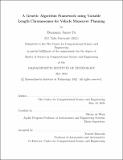A Genetic Algorithm Framework using Variable Length Chromosomes for Vehicle Maneuver Planning
Author(s)
Yu, Benjamin James
DownloadThesis PDF (4.531Mb)
Advisor
de Weck, Olivier
Terms of use
Metadata
Show full item recordAbstract
Incorporating reconfigurability demonstrates great potential in increasing the performance and/or lowering the cost of complex systems. Reconfigurability enables a system to adapt and dynamically respond to the specific objectives it encounters, rather than simply being optimized towards a general case. One such class of reconfigurable systems are fleets of maneuvering vehicles. Considering this class naturally leads to the question of how to generate the optimal set of maneuvers over an operational campaign. This thesis presents a genetic algorithm framework with Variable Length Chromosomes (VLC) to find this optimal set of maneuvers. Said framework generates Pareto optimal sets of maneuvers using non-dominated sorting genetic algorithm II (NSGA-II). The use of VLC removes the necessity for a human designer to impose a priori assumptions on the number and/or timing of vehicle maneuvers. Instead, the optimizer is freed to grow or reduce the number of maneuvers as needed. In addition, the use of a genetic algorithm approach enables the framework to evaluate problem domains and constraints which include non-linear behavior, discontinuities, and nonsmoothness. A small simplified 1D abstract problem is formulated and solved with this framework to familiarize the reader, before two case studies: (1) a reconfigurable satellite constellation observing Earth targets, and (2) an ocean-going maneuvering platform completing a cross-Atlantic voyage while simultaneously offering itself as a calibration target to overhead Low Earth Orbit (LEO) satellites, are explored indepth. The analysis shows that maneuver plans generated from the framework can increase the imaging performance of reconfigurable satellites by 25 to 35 percent, and the calibration metric for the ocean-going platform by up to 40 percent. Throughout this thesis, the key design decisions of the framework are discussed. The framework itself is available as Julia code, which has been written to take full advantage of any distributed computing cluster, particularly those managed by SLURM.
Date issued
2022-05Department
Massachusetts Institute of Technology. Center for Computational Science and EngineeringPublisher
Massachusetts Institute of Technology